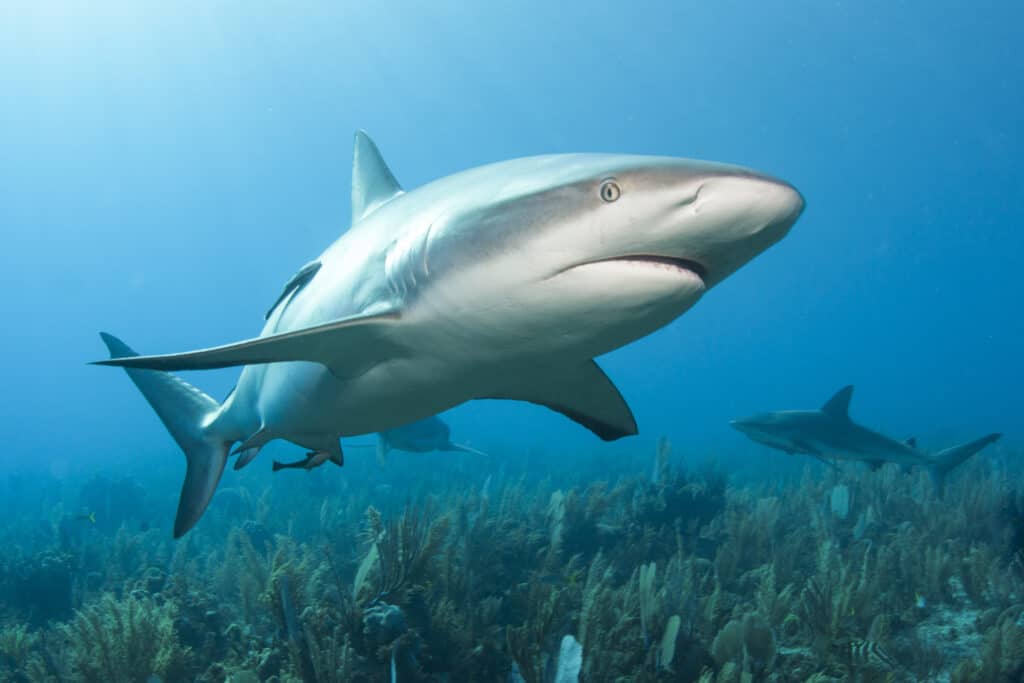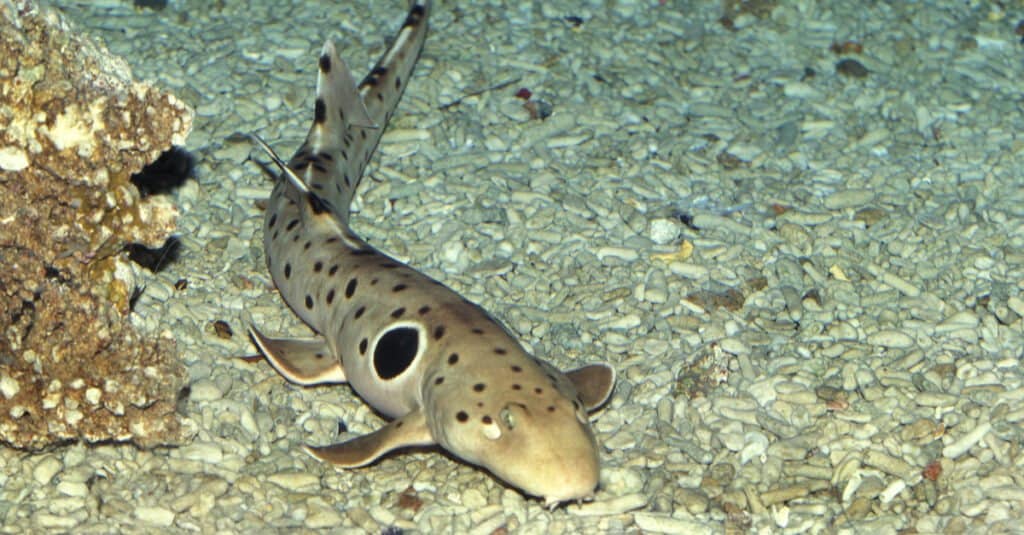“Four new walking sharks found in tropical waters” is how the most important headlines of very early 2020 sounded for aquatic life enthusiasts. The news of walking sharks surprised most people, with some asking if the species could become a terrestrial apex predator in the future.
The possibilities are endless. At the moment, however, there are certain species of sharks that can walk. The critical question, however, is what do they use as legs? You can find the answers and many more below!
How many legs do sharks have?

Sharks rely on eight fins for aquatic movement.
©wildestanimal/Shutterstock.com
Sharks do not have legs yet? Instead, they rely on eight fins for aquatic movement. These are a pair of pectoral fins, two dorsal fins, a pair of pelvic fins, a caudal fin, and an anal fin. Each fin has a role in stabilization, steering, propulsion, and lift control during swimming. The dorsal fins, for example, prevent sharks from rolling out of control.
Epaulette sharks, as you’ll see below, evolved to use their fins for land movement, just like legs. Their fins are, however, far from what we humans know and use as legs, so to speak.
Are sharks evolving to walk?
Sharks are indeed evolving to walk. According to research, species like the epaulette shark learned how to walk due to individuals or groups of the same species moving to a new area that forced them to walk.
For instance, epaulette sharks nowadays prefer shallow waters with sandy bottoms. As such, we can assume that a group of sharks once traveled to such waters in search of food and had to walk rather than swim to adapt to the new living conditions appropriately – or should we say “swimming conditions?”
Mark Erdmann, one of the study’s co-authors that analyzed species of walking sharks, suggested that such evolution was possible because specimens became isolated. Isolation and living conditions led to the species’ learning to swim. At the same time, if breeding occurred, offspring would also learn to walk.
At the same time, the ability to walk can also help remove the specimens from isolation. In this case, they’ll travel to a new location and eventually share the ability with other species.
Are there sharks with legs?

There are no sharks with legs.
©Konstantin Novikov/Shutterstock.com
There are no sharks with legs. Certain species, however, can use their evolved pelvic and pectoral fins to walk on the ocean floor. As such, one could say that every shark that can use these fins to walk is a shark with legs.
An interesting aspect regarding this entire ordeal is the fact that sharks haven’t experienced many evolutionary changes since prehistoric times. For example, the megalodon, the largest shark to ever swim in our planet’s waters, is extremely similar to a shark. Of course, the main difference is the impressive size of the megalodon.
So, you can understand why enthusiasts and scientists alike were surprised when they found a species that could walk on land – or at least on the sandy ocean floor. The ability to walk was certainly the least expected from a species known for formidable swimming and predatory aquatic skills.
Which shark can walk on land?

The epaulette shark is the only shark that can
walkon land.
©slowmotiongli/Shutterstock.com
The epaulette shark is the only shark that can walk on land. It is not the only species, however. According to the study that M. Erdmann co-authored, the entire Hemiscyllium genus (nine described species) is capable of using their pelvic and pectoral fins to walk on land.
What is the epaulette shark?
Hemiscyllium ocellatum (epaulette shark) and Hemiscyllium michaeli (leopard epaulette shark) are species that feed on the bottom of the water. Their main hunting grounds are sand and coral reef areas, mainly because they are populated by small fish. The diet of the epaulette shark consists mainly of crabs, worms, invertebrates, shrimp, and bony fish. The species is not a danger to humans.
Research suggests that the species evolved to walk on the ocean floor to better reach snails, crustaceans, and small fish hiding around rocks and coral. When feeding, it is easier for the epaulette shark to stop swimming and use its fins to walk instead.
Can the epaulette shark walk on dry land?
Even though this shark doesn’t actually walk on dry land, strong currents often drain all the water in its area. This happens because they’re often found in tide pools, which tend to turn dry with strong currents.
While most species would gasp for water in a matter of minutes, the epaulette shark can stay out of water for up to three hours. How so?
The epaulette shark is known for its ability to cope with severe oxygen depletion and survive complete anoxia for about two hours. This evolutionary change occurred due to the species living in tidal pools, which lack oxygen during the night. In environments poor in oxygen, the shark can increase brain blood supply and shut down (selectively) other non-essential neural functions.
Therefore, even when currents drain their tidal pools, epaulette sharks have up to three hours to walk back to the water.
Is there a shark that can breathe on land?

All sharks have gills, and because of this, they cannot breathe on land.
©ilan elgrably/Shutterstock.com
All sharks have gills, and because of this, they cannot breathe on land. The gills of a shark, unlike our lungs, can absorb oxygen only from oxygenated water. The only species of shark that can survive (not breathe) on land for extended periods is the epaulette shark.
At the same time, some species must constantly swim to get oxygenated water over their gills, or they die. Some species are capable of moving their pharynx in a pumping motion. This gives them the ability to stop swimming but keep on breathing.
Can sharks evolve to become terrestrial apex predators?
Reptilians, unlike sharks, are equipped with larger brains; the advantage is clear. Even if sharks evolved enough to walk and breathe on land, they could not become apex predators. Their main competition would be large reptiles that share the same ecological niche.
Another aspect would be that sharks are cold-blooded and rather large animals. This means that they could only live in tropical environments if they were to walk and breathe on land. Either pythons or crocodilians would stop their journey to becoming terrestrial apex predators.
Sharks with legs: is this possible?
No, probably not. It is extremely unlikely that we’ll ever see sharks with legs – or significantly evolved fins – walking on land like humans or four-footed mammals. While the epaulette shark appears to have evolved to walk in recent times, it would take hundreds of millions of years – and the proper circumstances – for sharks to develop legs.
A study found hints that, about 400 million years ago, a common ancestor of mammals and sharks could walk on land. Researchers discovered nerve networks that were initially found only in land animals that evolved from fish in species of basal sharks. As we all know, sharks didn’t evolve or devolve from land animals, so they couldn’t possess such nerve networks.
The photo featured at the top of this post is ©
Thank you for reading! Have some feedback for us? Contact the AZ Animals editorial team.






